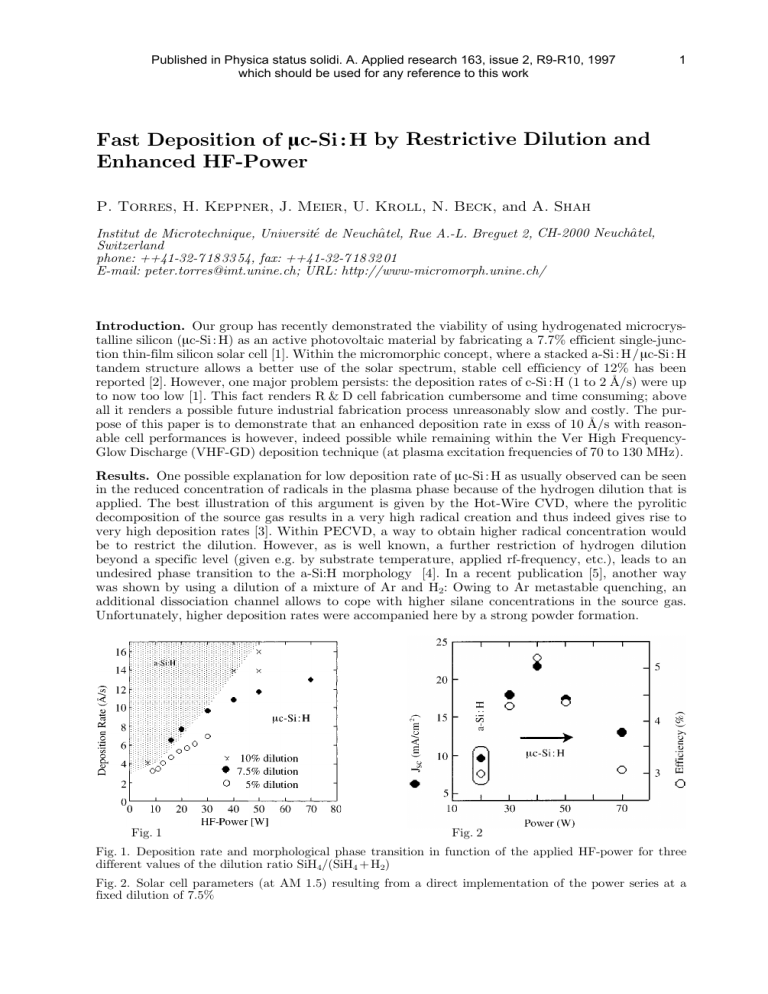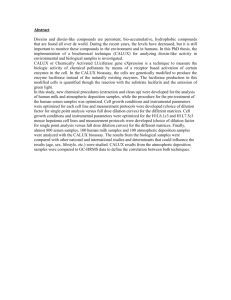Fast Deposition of µc-Si:H by Restrictive Dilution and
advertisement

Published in Physica status solidi. A. Applied research 163, issue 2, R9-R10, 1997 which should be used for any reference to this work 1 Fast Deposition of mc-Si : H by Restrictive Dilution and Enhanced HF-Power P. Torres, H. Keppner, J. Meier, U. Kroll, N. Beck, and A. Shah atel, Institut de Microtechnique, Universit e de Neuch^ atel, Rue A.-L. Breguet 2, CH-2000 Neuch^ Switzerland phone: ++41-32-7 18 33 54, fax: ++41-32-7 18 32 01 E-mail: peter.torres@imt.unine.ch; URL: http://www-micromorph.unine.ch/ Introduction. Our group has recently demonstrated the viability of using hydrogenated microcrystalline silicon (mc-Si : H) as an active photovoltaic material by fabricating a 7.7% efficient single-junction thin-film silicon solar cell [1]. Within the micromorphic concept, where a stacked a-Si : H/mc-Si : H tandem structure allows a better use of the solar spectrum, stable cell efficiency of 12% has been reported [2]. However, one major problem persists: the deposition rates of c-Si : H (1 to 2 A/s) were up to now too low [1]. This fact renders R & D cell fabrication cumbersome and time consuming; above all it renders a possible future industrial fabrication process unreasonably slow and costly. The purpose of this paper is to demonstrate that an enhanced deposition rate in exss of 10 A/s with reasonable cell performances is however, indeed possible while remaining within the Ver High FrequencyGlow Discharge (VHF-GD) deposition technique (at plasma excitation frequencies of 70 to 130 MHz). Results. One possible explanation for low deposition rate of mc-Si : H as usually observed can be seen in the reduced concentration of radicals in the plasma phase because of the hydrogen dilution that is applied. The best illustration of this argument is given by the Hot-Wire CVD, where the pyrolitic decomposition of the source gas results in a very high radical creation and thus indeed gives rise to very high deposition rates [3]. Within PECVD, a way to obtain higher radical concentration would be to restrict the dilution. However, as is well known, a further restriction of hydrogen dilution beyond a specific level (given e.g. by substrate temperature, applied rf-frequency, etc.), leads to an undesired phase transition to the a-Si:H morphology [4]. In a recent publication [5], another way was shown by using a dilution of a mixture of Ar and H2: Owing to Ar metastable quenching, an additional dissociation channel allows to cope with higher silane concentrations in the source gas. Unfortunately, higher deposition rates were accompanied here by a strong powder formation. Fig. 1 Fig. 2 Fig. 1. Deposition rate and morphological phase transition in function of the applied HF-power for three different values of the dilution ratio SiH4/(SiH4 + H2) Fig. 2. Solar cell parameters (at AM 1.5) resulting from a direct implementation of the power series at a fixed dilution of 7.5% 2 Table 1 Microcrystalline n±i±p silicon solar cells obtained so far at high deposition rates R ( A/s) h (%) Jsc (mA/cm2 FF (%) Voc (mV) 5.7 9.7 10.9 13.9 6.5 4.3 5.2 3.9 22.3 18 21.8 17.9 66 49 56 52 440 481 424 413 As illustrated in Fig. 1, a successful phase transition from a-Si : H towards mc-Si : H can indeed be induced by significantly enhanced HF-power levels under restricted dilutions (this phase transition was monitored by X-Ray, Raman-spectroscopy, IR absorption, PDS, Spectral Response). It is observed that at a constant HF-power the deposition rate increases by restricting the dilution and that for a given dilution the deposition rate scales with the applied HF-power level. Note, that for a dilution of 5% SiH4/(SiH4 + H2) the morphology remains mc-Si : H for the whole investigated HFpower range [6], but that at 7.5% dilution we observe a phase transition controlled only by the applied HF-power. This power-controlled phase transition is confirmed in a further (albeit non-systematical) experiment at an even more restricted dilution of 10%; one reaches here a deposition rate of 16 A/s for mc-Si : H without any observable powder formation. Direct implementation of these results (without further optimisation) in n±i±p solar cells shows that there is an optimum for the applied HF-power at 40 W (Fig. 2) for this specific case of 7.5% dilution. In Table 1 we give results on solar cells as obtained so far at different deposition rates. However, one should note that at the present state of our research it is yet not clear if higher deposition rates do correlate with lower efficiencies as one may be led to conclude from Fig. 2: The somewhat lower efficiencies obtained may be due to other factors (e.g. interface problems). On the other hand, it was indeed already known that high HF-power levels are beneficial for mc-Si : H growth at the standard PECVD excitation frequency of 13.56 MHz [7]; however what is new here, is that deposition rates of mc-Si : H can exceed 10 A/s (at a substrate temperature as low as 220 C), and this with reasonable device performances, as illustrated in Tab. 1. We speculate that such high power levels have no detrimental effects on the ongrowing film because of the low impact energy of ions coming from the plasma phase: this fact is known for VHF-conditions as used in this work. Conclusions. It is shown that it is possible to control the morphological transition from a-Si : H to mc-Si : H for a certain dilution by the applied HF-power only. By doing this, powder-free deposition of mc-Si : H at rates up to 16 A/s has been achieved. A mc-Si : H solar cell grown at a deposition rate of 10.9 A/s with an energy conversion efficiency of 5.2% illustrates that the VHF-GD deposition technique allows one indeed to obtain device-quality mc-Si : H material at reasonably fast deposition rates. References [1] J. Meier, P. Torres, R. Platz, S. Dubail, U. Kroll, J. A. A. Selvan, N. P. Vaucher, Á C. Hof, D. Fischer, H. Keppner, A. Shah, K.-D. Ufert, P. Giannoules, and J. Koehler, Mat. Res. Soc. Symp. Proc. 420, 3 (1996). [2] J. Meier, S. Dubail, J. Cuperus, U. Kroll, R. Platz, P. Torres, J. A. A. Selvan, P. Pernet, N. Beck, N. P. Vaucher, C. Hof, D. Fischer, H. Keppner, and A. Shah, to be published in J. Non-Cryst. Solids (ICAMS 17) (1997). [3] A. R. Middya, A. Lloret, J. Perrin, J. Huc, J. L. Moncel, J. Y. Parey, and G. Rose, Mat. Res. Soc. Symp. Proc. 377, 119 (1995). [4] N. Beck, P. Torres, J. Fric, Z. Remes, A. Poruba, H. Stuchlikova, A. Fejfar, N. Wyrsch, M. Vanecek, J. Kocka, and A. Shah, Mat. Res. Soc. Symp. Proc. 452, 761 (1997). [5] H. Keppner, P. Torres, J. Meier, R. Platz, D. Fischer, U. Kroll, S. Dubail, J. A. A. Selvan, N. P. Vaucher, Y. Ziegler, R. Tscharner, C. Hof, N. Beck, M. Goetz, P. Pernet, M. Goerlitzer, N. Wyrsch, J. Veuilly, J. Cuperus, A. Shah, and J. Pohl, Mat. Res. Soc. Symp. Proc. 452, 865 (1997). [6] M. Goerlitzer, P. Torres, N. Beck, N. Wyrsch, U. Kroll, H. Keppner, J. Pohl, and A. Shah, to be published in J. Non-Cryst. Solids (ICAMS 17) (1997). [7] A. Matsuda, J. Non-Cryst. Solids 59/60, 767 (1983).



